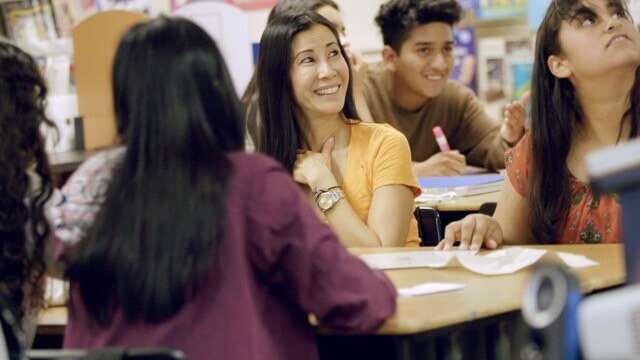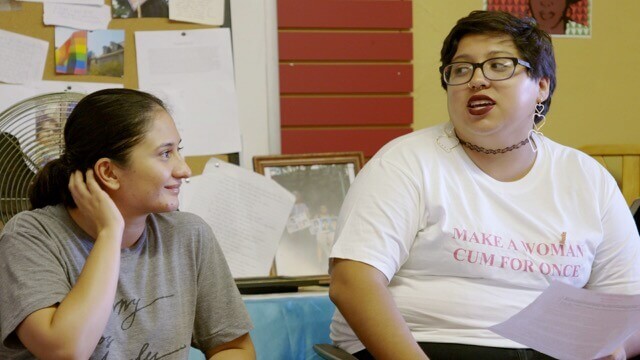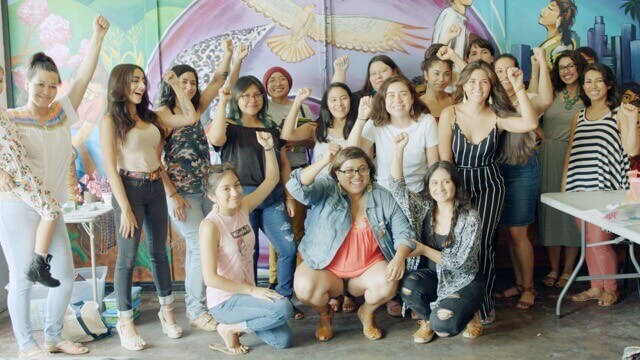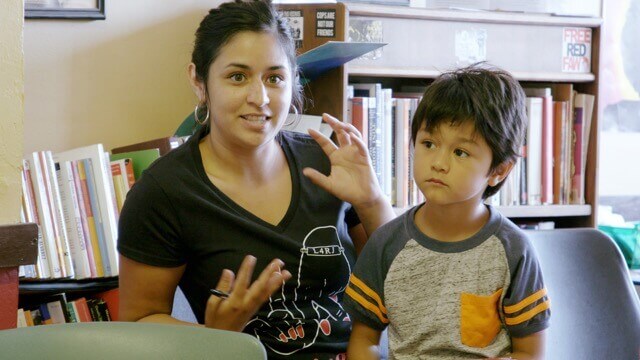
As a journalist, I have confronted a Pakistani government official about nuclear proliferation. I've interrogated a leader of the Revolutionary Armed Forces of Colombia about drug trafficking. I've even stared down a member of the Taliban in Afghanistan when he told my escort that I was out of line for speaking too loudly in public.
But for some reason, whenever I've had to talk to someone about matters pertaining to sex, my heart begins to pulsate wildly and I start to giggle involuntarily. Throughout the years, I've profiled swingers, people who practice polyamory, those into kink and countless sex workers. Inevitably though, when asking about specifics, I become that little girl, who at 8 years old was told by my grandmother, "never let a man see you naked — even your husband."
Yes, she really said that. Grannie proceeded to tell me that all of her interactions with her husband, my grandfather, happened in the dark. And that was with her own husband. Sex before marriage was a non-starter. My other grandmother, a devout Christian, had persistent, dire warnings for me: "never commit the sex sin."
Then, in Mrs. Spect's 5th grade class, a permission slip went out to all of the parents for consent to allow their kid to sit through a two-hour sex ed discussion. Every kid in the class came back with a parent's signature except one: me. Incidentally, if my recollection serves me right, I believe I was the only Asian kid in the class as well. Asians as a culture aren't exactly the most communicative bunch, especially when it comes to personal matters. I told my teacher that my dad flatly refused to sign the paper, saying, "Sex ed in 5th grade? No way!"
Mrs. Spect felt compelled to make a personal visit to my home to talk to my father. I recall her telling me that it was the first time she ever went to a student's house. She explained to Dad that the course was more about anatomy than sex. It was important, she said, for kids this age to be aware of their bodies in order to be able to keep themselves safe. Not to mention, she added, that I would be the only kid to have to leave the classroom and go to the library while the course was in progress. Dad reluctantly agreed, but the whole scenario left me feeling pretty ashamed.
That's pretty much how I've always felt about sex -- ashamed. Let's put it this way, it took me a long time to be able to have the lights on during intimate moments.
But I don't think I'm alone in still finding it hard to talk openly about sex. And that, as I've learned first-hand, can adversely affect one's relationships and health.
Now in my forties, I can honestly say that my inability to talk about sex has led to some risky behavior throughout my life. I haven't always been responsible about condom or birth control use, so I've left myself open on numerous occasions to unwanted pregnancies and STDs, both of which are rampant in our country, the latter now more than ever.
While our teenage and unwanted pregnancy rates have declined significantly, we lag far behind many other industrialized nations, and have gaping disparities based on race/ethnicity, income and geographical location. And across the board, our STD rates have reached an all-time high. We spend an estimated $16 billion treating sexually transmitted diseases every year. $16 BILLION.
Access to affordable healthcare services is certainly an important factor, but how much of this is driven by societal stigma and taboos when it comes to having real, honest conversations about sex in America?
As the mother of two little girls, one of whom is 4 years old and constantly asking about how Mommy and Daddy made her, I know that I don't want to impart fear and shame onto my daughters when it comes to sex. I want them, one day, to be able to enjoy it, while knowing that not being careful and communicative can have dangerous emotional and physical consequences.
Because sex, after all, is nothing to giggle about.
Lisa Ling is the executive producer and host of "This is Life with Lisa Ling," which airs Sundays at 10 p.m. ET/PT starting October 1 on CNN. You can follow her on Twitter, Instagram and Facebook.
"Stigma has prevented people from living whole lives," said Jesse Milan, Jr., the president and CEO of AIDS United.
Milan lost his partner during the height of the epidemic, and has himself lived with HIV for 35 years. He says that stigma keeps people from getting tested, accessing health care, accessing support, and from disclosing their status to their sexual partners.
The reluctance to get tested and treated has real consequences. Of the 1.1 million Americans living with HIV today, one in seven haven't been diagnosed, according to the CDC. Among young people under the age of 25, that number is one in two -- 51% don't know they have the virus. HIV is disproportionately spread by those who don't know they're positive.
Despite the efficacy of ART, only 30% of people living with HIV in America are virally suppressed. Of those who are not virally suppressed, 66% have been diagnosed, but are not receiving treatment.
When one partner is HIV positive and the other is negative, PreP has the potential to play a crucial role in reducing stigma, supporters say, by helping to redistribute the responsibility of prevention between both positive and negative individuals.
"I completely respect the people that are going on PrEP," said Villalobos, "because not only are they protecting themselves, but it sends a message back to the HIV community that they're aware of what's available to them and they want to do their part."
But this new method of prevention itself has been stigmatized. Similar to what can happen to women on birth control, Villalobos says there is "slut shaming" of those on PrEP based on a fear that it will lead to an increase in condomless sex and a higher number of sexual partners.
Dating app disclosure:
"Doomed to a life a disease"
Oh god here we go with "my boyfriend at the time gave it to me" story. It's not funny? It is funny to me that you walking biohazards never learn your lesson and yet here you are taking more loads.
I'm not a biohazard and it wasn't my boyfriend. I'm not taking loads. Literally nothing you say is accurate. Why are you being so verbally aggressive when you don't even know me?
Because. You mean aggressive typing. I hate seeing guys like you Will. You're a shining example of why the fag world is disgusting and vile and why we're all doomed to a life of disease.
HIV won't kill you Will. But your meds will :)
I'm sorry
8:58pmNo your diction. It's very aggresssive and vulgar considering it's to somebody you don't know.
8:58pmAnd you must not know much about the meds then.
8:59pmI'm sorry for what happened to you. You're another man wasted. The meds will mess your organs up. It might not happen now but it might happen 20 years from now.
8:59pmI'm not wasted by any means.
Delivered 9:00pmSTDs are at an all-time high, according to the CDC, and some are placing blame on a "hookup culture" fueled by online dating and adult social networking apps. Others say these apps can become an effective tool for disclosure and prevention.
For now, the efforts to use dating and hookup apps to promote disclosures have been primarily focused on HIV in particular, and found on the apps specifically marketed toward men who have sex with men, the group that accounts for the majority of HIV diagnoses in the US.
On many of the apps, users have the option to include their HIV status -- Positive, Positive and undetectable, Negative, Negative and on PrEP, Don't know -- in their profiles. Some, like Grindr and Hornet, include fields for users to plug in the date they were last tested.
Hornet sends users reminders to go in for testing or treatment every six months, according to the last test date they've entered on the app. These features aren't just in place to help people get and stay healthy and make sex safer, says Hornet's Senior Health Innovation Strategist Alex Garner, but to break down stigma by fostering community.
"These apps allow gay men who are positive to find one another," said Garner, who has been living with HIV for over 21 years. He says men are on the apps for friendship and community, not just dates and hookups. "It alleviates isolation, which is so profound."
Hornet does not allow users to filter men who are positive out of their search results in an attempt to limit discrimination and online harassment, Garner notes.
Dating app disclosure:
"Thanks man. Appreciate the heads up."
So you're aware, I'm +/undetectable
5:53pmThanks man. Appreciate the heads up of course
5:54pmIs that an issue? It often is, and I can't tell from your response lol
6:04pmMight be a little slower to hop into bed but once i understand you and trust each other shouldn't be too different :-)
6:05pmK, that's fair ;-)
6:06pmOften, the response is an immediate block, so ...
6:06pmI feel you. Hope that's not too hard to deal with
6:07pmSweet of you to say! You already have demonstrated a lot more empathy than most
6:10pmSo, thanks!
Delivered 6:11pmNestor Rogel, 27, heterosexual and single, says he's never seen anything like that on any of the apps he's been on, such as Tinder or Bumble. But as someone who was born with HIV and has never known a dating life without the virus, he's eager to get the disclosure conversation out of the way early on.
"If someone is willing to leave just because of this, they're not the right person for me," said Rogel, a student at California State University, Dominguez Hills.
Once, after two weeks of dating, he even took a girlfriend to his doctor's office with him, where she had the opportunity to get information on Rogel's health and risk of transmitting straight from a medical professional. They ended up dating long-term.
Today, he has the letters and symbol "HIV +" tattooed on his forearm -- a way of making a statement in the face of societal stigma and being, as he calls it, "unapologetically positive."
Back on the market now, Rogel says the constant rejection is painful. "'Human' is the first word in 'HIV'," he pointed out of the acronym for the virus, "but your humanity is first to get taken away."
Still, not disclosing his status before a relationship becomes sexual is a choice he knows in dozens of states across the country could land him in prison.
How states criminalize HIV
HIV criminalization laws target behavior believed to expose others to the virus. They were enacted primarily in the '80s and '90s when much less was known about how the virus was transmitted. For example, in several states, spitting while HIV positive is a criminal offense, even though the CDC says HIV isn't transmitted through saliva.
They were also written in a time before ART and PrEP revolutionized transmission risk, and before treatment allowed for HIV to be considered a manageable chronic disease with a near-normal life expectancy, according to the CDC.
By treating disclosure as a criminal issue, rather than a public health issue, researchers, lawmakers, and public health officials say these laws both reflect and perpetuate stigma.
"There was ignorance. People were afraid, people didn't know how to respond. These laws were passed in that moment," says Rep. Barbara Lee, a California Democrat who has worked on issues around HIV and AIDS throughout her career. This past spring, she reintroduced the REPEAL HIV Discrimination Act in Congress with co-sponsor Rep. Ileana Ros-Lehtinen, a Florida Republican.
Though the virus is primarily spread by those who don't know they have it, these laws target only those who know they have tested positive and fail to disclose their status -- regardless of whether or not it has been demonstrated that they were intentionally trying to transmit the virus to others.
"We need to encourage more testing, more care, more treatment, rather than having laws that make people worry more about coming forward," Lee said.
Sean Strub, Executive Director of the Sero Project, an organization working on HIV criminalization reform, says that these laws have created a "viral underclass" by singling out HIV among other communicable diseases. About two dozen states also have STD or communicable disease criminal statutes, but those are rarely enforced and are more often misdemeanors, as opposed to felony charges.
"More women die of cervical cancer from strains of HPV, than die of AIDS from HIV in the US," said Strub. "It's based in bias against gay people, people of color, and drug users who are more likely to carry HIV."
According to the CDC, 1,783 women in the US died from HIV or AIDS in 2014, the most recent year for which numbers are available. That same year, nearly two and a half times as many women died from cervical cancer -- 4,115. Ninety one percent of those cancers were likely caused by HPV.
As for Chris Villalobos, he tries to combat moments of stigmatization with education, turning conversations on Grindr into teachable moments about the virus. And for this new sense of purpose, he's grateful.
"HIV, this is one of the best things that's ever happened to me," he said. "It was that wake-up moment when I said, 'Okay, let's do something. Let's go and live. Let's actually make a difference'."
UPDATE: This story has been updated to reflect new messaging from the CDC on the risk of someone transmitting HIV to a partner if they're undergoing antiretroviral therapy and have a suppressed viral load.
Control
The personal and political: What sexual self-determination looks like for women today
Meet a new generation of women fighting for reproductive rights for all women, and go inside a lab developing a birth control pill ... for men. Lisa Ling explores the past present and future of birth control in America.
"Make a woman cum for once." These words were screen printed in bold pink typeface across Alina Aguayo's white t-shirt.
It was a sticky summer day in South Central Los Angeles and the iron rod door to the Casa Solidaria del Sur community center was open to let in the breeze. Inside, 21-year-old Aguayo and other members of the Los Angeles chapter of the California Latinas for Reproductive Justice, and guests, were gathered in a circle for an all-female attended workshop on sex and body positivity.
"It was really hard coming to terms with my sexuality as mine," Aguayo, a gender studies student at Santa Monica Community College, shared with the group. She recalled that in sex ed class in high school, sex was framed solely around the male orgasm and the process of reproduction, with no mention of female sexual pleasure, she said.
"You're supposed to only have sex within the institution of marriage, that's the only place we're allowed, or have permission," said 25-year-old Carina Reyes, recalling the abstinence-only teachings from her Catholic school education. "As if we need permission to express ourselves."
According to these women, challenging deeply entrenched societal and cultural norms around female sexuality is one part of a multifaceted fight for reproductive justice, which focuses not only on reproductive rights, but also the factors of social, political and economic inequality that impact a woman's ability to exercise those rights fully.
"Reproductive justice," Aguayo read aloud a definition of the term to the group, "cannot exist without self-determination."
In America, sexual self-determination -- for women of color in particular -- is often a politicized act.

In the not-so-distant past, forced and coerced sterilizations were legal in the majority of US states, government-funded, and upheld by the US Supreme Court. A tool used by eugenicists through the 1970s, women of color, immigrant women, poor women and unwed mothers, among others, were deemed "feeble-minded" or "unfit" and sterilized without their consent by the tens of thousands across the country.
"They would come in to have babies and find their tubes tied at the end," said Dr. Elaine Tyler May, Regents Professor of American Studies and History and Chair of the Department of History at the University of Minnesota.
In 2013, North Carolina became the first state to pass legislation to provide financial reparations to the living victims of these state-run programs. In 2015, Virginia followed suit.
With this fraught history in mind, Laura Jiménez, Executive Director of California Latinas for Reproductive Justice, says that the movement must focus on, not only the right to not parent, but also on the right to parent in a safe and supportive environment.
"If we are advocating for access to reproductive healthcare for everyone it has to be because we believe in bodily autonomy for everyone," said Jiménez, "not because we want to control those people's reproduction because they're too poor, or too brown, or too immigrant."
US unintended pregnancy rates by race/ethnicity
Source: New England Journal of Medicine, 2016
Reyes, the community engagement coordinator for the policy advocacy and community education organization, said Latinas are often hypersexualized in pop culture and media representations. Then, she said, they're simultaneously demonized for their sexuality in real life.
Reyes says some lawmakers prop up what she calls the "false narrative of the 'welfare queen' -- how women are just trying to have a lot of babies to try and leech off the system."
Lorena García Zermeño, Program Coordinator for the organization, added that discussions about Latinas leading the rates of teen pregnancy in the US often exclude the fact that this group disproportionately lacks access to financial resources and preventive health care services.

"It shames and blames young parents for conditions that we're not addressing," said García Zermeño, "It's using a punitive framework that focuses on individual behavior, rather than addressing those systemic barriers that are present."
Advocates say those systemic barriers include the accessibility and affordability of reproductive health and family planning services, such as prescription contraception.
In the US, nearly half of all pregnancies are unintended, according to the Centers for Disease Control and Prevention. Forty five percent are either unwanted or mistimed, a substantially higher rate than most other industrialized nations. And the racial and income disparities in the US are profound. According to a study published by the New England Journal of Medicine in 2016, Latinas are nearly twice as likely to experience an unintended pregnancy compared to non-hispanic white women. Black women are nearly two and a half times as likely. Women in the lowest income bracket experience unintended pregnancies at five times the rate of women in the highest income bracket.
Women with lower incomes have higher rates of unintended pregnancy
Source: CDC National Survey of Family Growth
The Affordable Care Act sought to expand access to all FDA-approved forms of birth control with its contraceptive mandate, in effect since 2011, requiring health insurance plans to fully cover the cost of contraceptives. Some conservatives and religious groups opposed the provision and by 2014, the US Supreme Court ruled in Burwell v. Hobby Lobby that certain for-profit companies could be exempted from including birth control in their employee's health insurance plans based on the employer's personal religious beliefs.
Since the ACA's contraceptive mandate went into effect, over 55 million women have gained access to free birth control, according to a 2015 report from the Department of Health and Human Services.
Recent attempts by President Trump and Republicans in Congress to repeal the ACA have coincided with reported spikes in women seeking IUDs, a form of long-acting reversible contraception, many of which, once implanted, would last a woman through the duration of the current administration.

"It's more than liberation, it's a necessity and it's a right," said Reyes, mother to a five-year-old son, Leonardo. "We need this birth control in order to plan accordingly with the needs and the circumstances of our families."
As a student and a then-single mother, she says she would not have been able to afford the IUD she got after the birth of her child, were it not covered and had she not been able to see a provider at a low-cost women's clinic that accepted her Medicaid insurance. Without insurance, the cost of IUDs ranges between $500 to $850, and an additional $150 to $250 for the insertion and removal procedures.
Of the 38 million women who are sexually active, able to become pregnant, but not trying to become pregnant, more than half -- 20 million -- rely on publicly funded clinics and services for birth control, according to the Guttmacher Institute, a research and policy organization focused on advancing sexual and reproductive health rights.
But access to these low-cost clinics, many of which also provide abortion services, have been jeopardized as new legislative regulations on abortion have closed clinics across the country. Earlier this year, Trump signed a bill allowing states to withhold federal funding from clinics that provide preventive health care services, like contraception, if they also provide abortion services. The most recent attempt to repeal and replace the Affordable Care Act would have defunded Planned Parenthood by preventing it from receiving reimbursements from Medicaid for a year. The measure was blocked -- for now -- by the Senate.
Where unintended pregnancy is most common
Source: Guttmacher Institute, 2015.
"Even though something is legal, all of the conditions in someone's life may not line up to make actual access a reality for them," said Jiménez.
Factors that impact a woman’s ability to exercise her reproductive rights include immigration status, proximity to the nearest health care provider, residency in a state that expanded Medicaid coverage under ACA along with access to paid leave and transportation. Women of color in the field of reproductive health and justice have been working hard to elevate this reality of intersectional barriers to access in the mainstream public discourse around the issue, Jiménez says.
"Until all of us have easy access, this battle is not won yet."